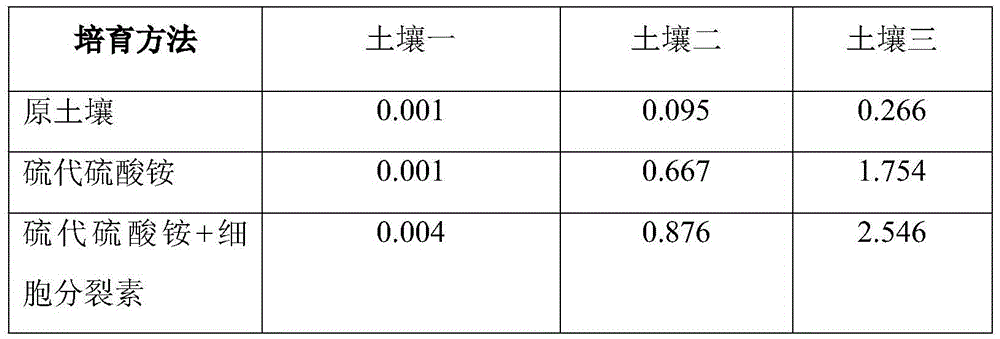Method for remediating mercury-contaminated soil by combining byproduct ammonium thiosulfate with calendula officinalis
A technology of ammonium thiosulfate and calendula, which is applied in the field of phytoremediation of heavy metal-contaminated soil, can solve the problems of low mercury bioavailability, achieve low cost, promote plant growth, and reduce environmental risks
- Summary
- Abstract
- Description
- Claims
- Application Information
AI Technical Summary
Problems solved by technology
Method used
Image
Examples
Embodiment 1
[0019] Embodiment one: the pot experiment of Calendula officinalis
[0020] 1. Experimental design and conditions:
[0021] The original soil sample used is grass vegetation soil within 0-20cm of the surface layer of the Zhongyuan green belt of Nanjing University of Information Science and Technology. The physical and chemical properties of the soil are shown in Table 1:
[0022] Table 1 Soil physical and chemical properties
[0023]
[0024] 2. Experimental design soil samples, three soil samples are as follows:
[0025] Soil 1: the above soil as it is;
[0026] Soil 2: add 2mg / kg mercury (HgCl 2 ) pollutes the soil;
[0027] Soil three: add 5mg / kg mercury (HgCl 2 ) pollutes the soil;
[0028] The above three soil samples were prepared in three groups, namely ① the control group, ② the ammonium thiosulfate compound treatment group, and ③ the ammonium thiosulfate + cytokinin compound treatment group, which were set up as shown in Table 2:
[0029] Table 2
[0030] ...
Embodiment 2
[0052]The difference from Example 1: in every kilogram of mercury-contaminated soil, apply a solution prepared by the by-product ammonium thiosulfate produced in the steelmaking wastewater treatment process of 4g, so as to absorb the excess mercury in the soil by Calendula officinalis the goal of.
Embodiment 3
[0054] The difference from Example 1: in every kilogram of mercury-contaminated soil, apply a solution prepared by the by-product ammonium thiosulfate produced in the steelmaking wastewater treatment process of 6g, so as to absorb the excess mercury in the soil by Calendula officinalis the goal of.
PUM
 Login to View More
Login to View More Abstract
Description
Claims
Application Information
 Login to View More
Login to View More - R&D
- Intellectual Property
- Life Sciences
- Materials
- Tech Scout
- Unparalleled Data Quality
- Higher Quality Content
- 60% Fewer Hallucinations
Browse by: Latest US Patents, China's latest patents, Technical Efficacy Thesaurus, Application Domain, Technology Topic, Popular Technical Reports.
© 2025 PatSnap. All rights reserved.Legal|Privacy policy|Modern Slavery Act Transparency Statement|Sitemap|About US| Contact US: help@patsnap.com



